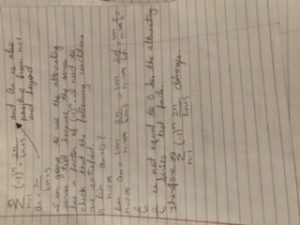See this post for more final exam information. You have all day Tuesday and all day Wednesday to complete your exam. Your final exam score = 2/3 written work + 1/3 interview.
- Read the Math Department Academic Integrity Policy
- Final exam interview signup: https://docs.google.com/spreadsheets/d/17ynCPZOestSrI1XxM8zEF8c06l7D1ooGs9vp7DAtWJU/edit?usp=sharing
- Sign up for an interview now.
- One third of your final exam grade will be based on your interview.
- Sign up for an available interview time ASAP.
- You’re under no obligation to schedule your interview on the weekend; those time slots are available just in case anyone wants them.
- If there are no time slots that work for you, send me an email and we’ll schedule your interview for a different time.
- Final exam WeBWorK access: http://mathww.citytech.cuny.edu/webwork2/Exams_-_MAT1575-MW
- Your final exam will be available in WeBWorK starting late Monday night (really Tuesday at 12:00am) and will be open until Wednesday at 11:59pm. This is a different WeBWorK link from the one you used all semester. This one is just for final exams (and practice exams, which you should take before Monday).
- Log in now if you haven’t already. You should have received an email from “WeBWorK Administrator” last week with your username and password. Even though it’s a brand new account, your username and password might be the same as they were for your other WeBWorK account, so you can try username: firstname.lastname and password: EMPLID.
- Let me know before Monday if you have any trouble logging in.
- Written work file upload: https://www.dropbox.com/request/tac5JKlV7WgnULlYeZ5p
- You will have 2 hours to complete the WeBWorK component and then 30 minutes to send me a your written work.
- Don’t forget:
- Check all antiderivatives by differentiating.
- State the name of any convergence test you use.
- Submit a single PDF of all your written work.
- Don’t forget to include your student ID in the pictures of your hand-written work.
- Use the link above; don’t use email.
- Interview meeting links will be sent to your email address.
- Make sure you understand everything that you’re writing down and can explain it!
- Practice explaining your work out loud before the interview.
- Make sure you can answer questions like, “Why? How did you know to write that?”
- “Because I saw a guy on YouTube do it,” is not an acceptable answer.
- “Because that’s the rule,” is not an acceptable answer.






Recent Comments